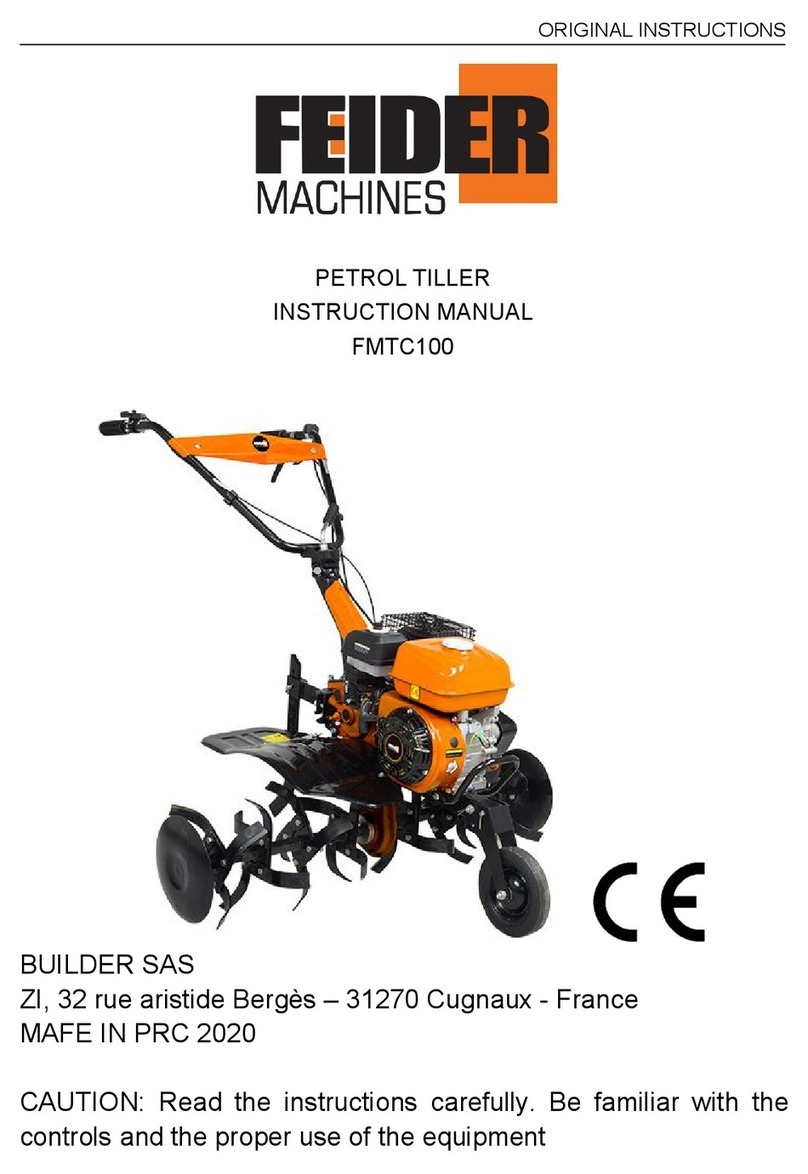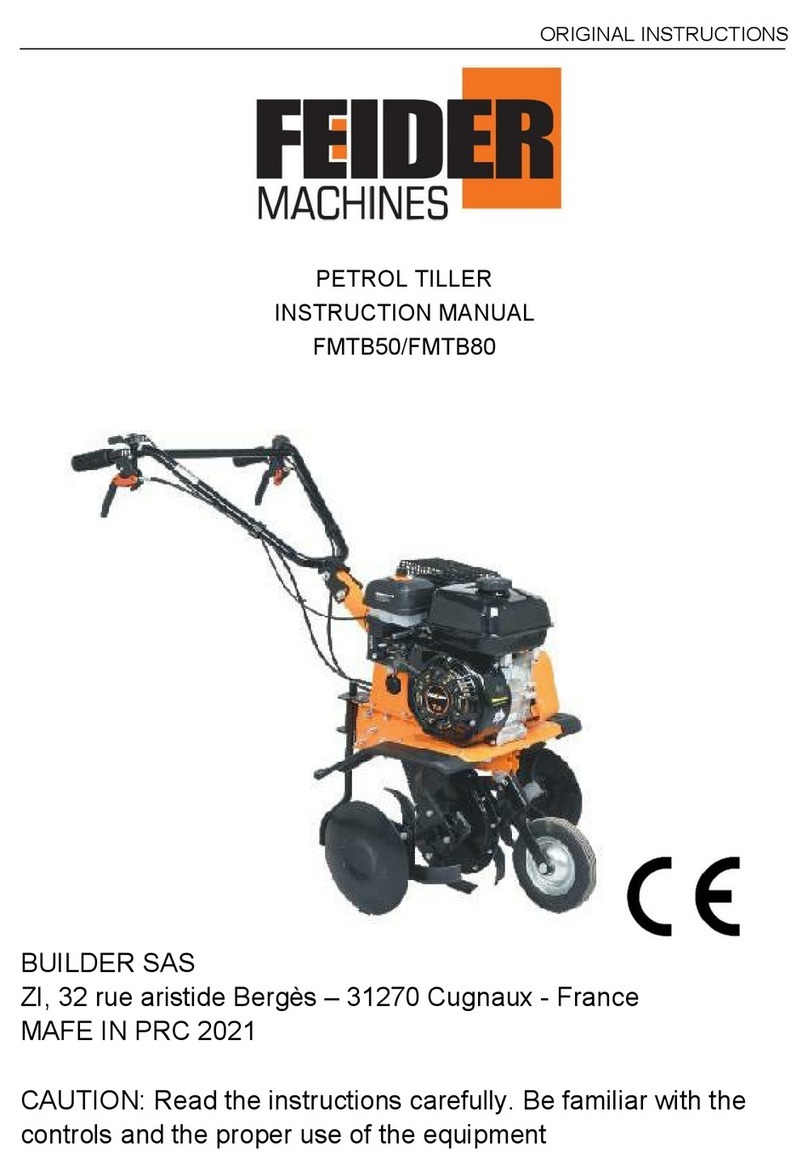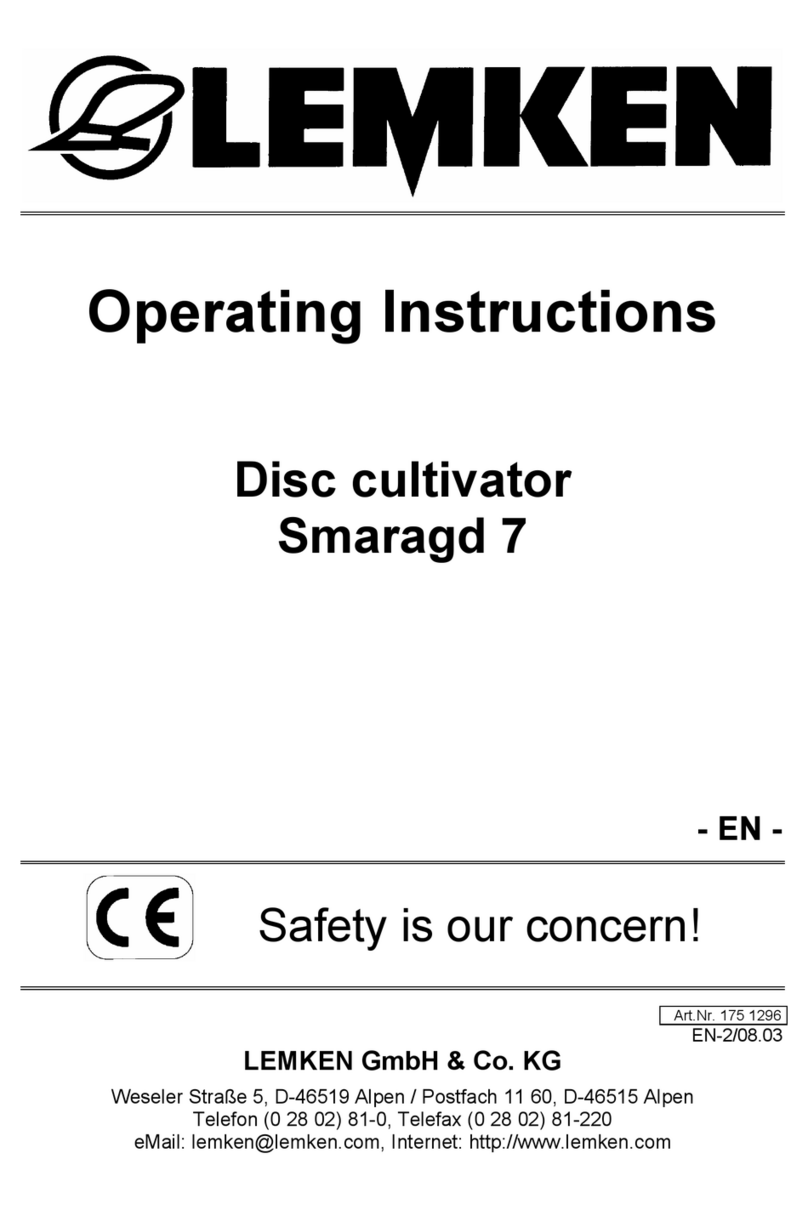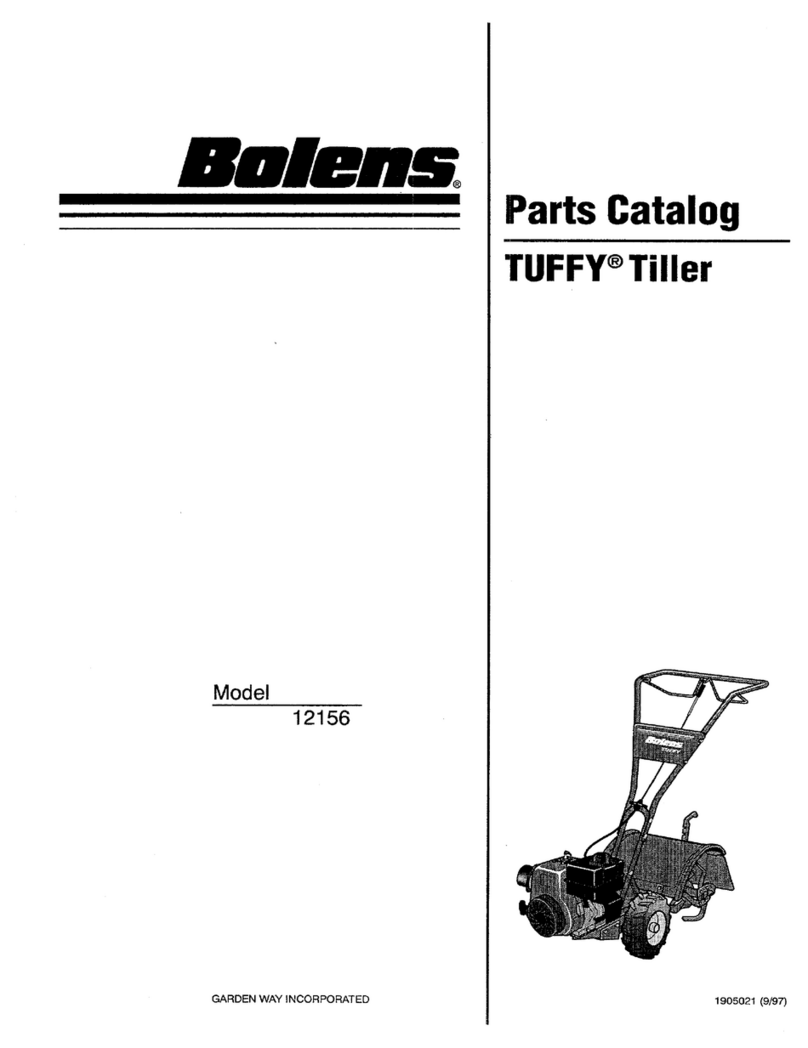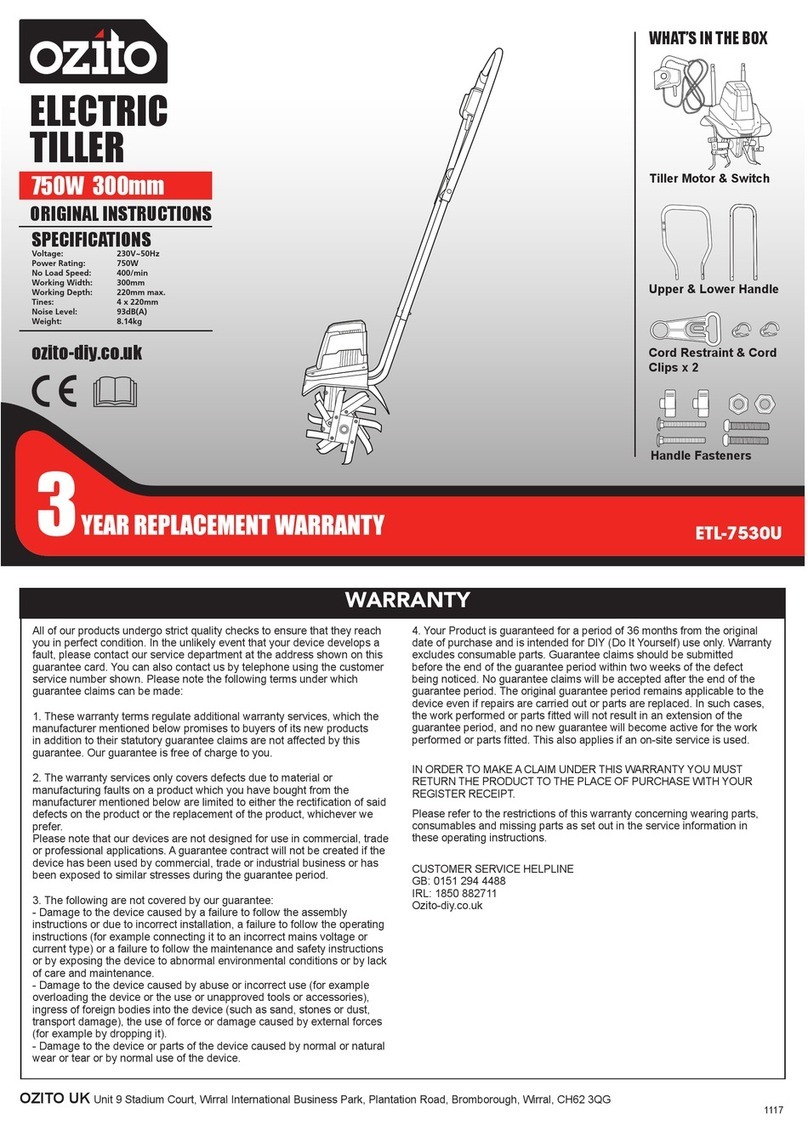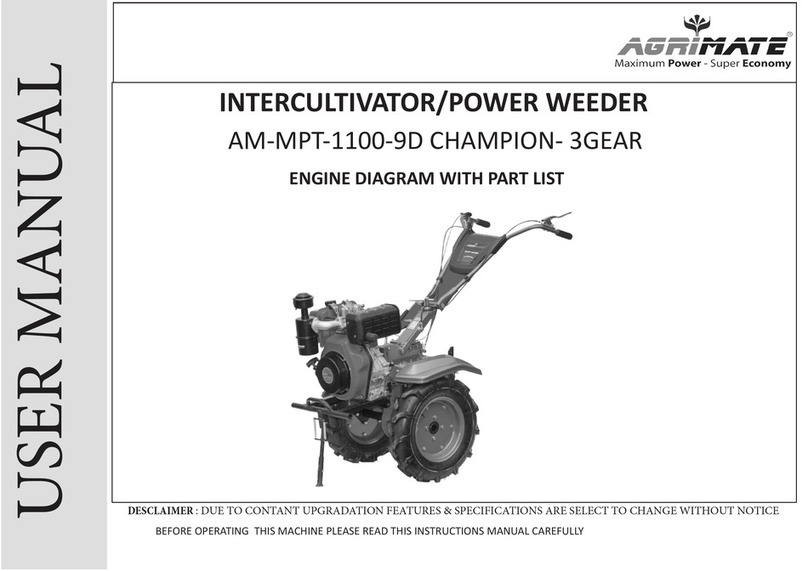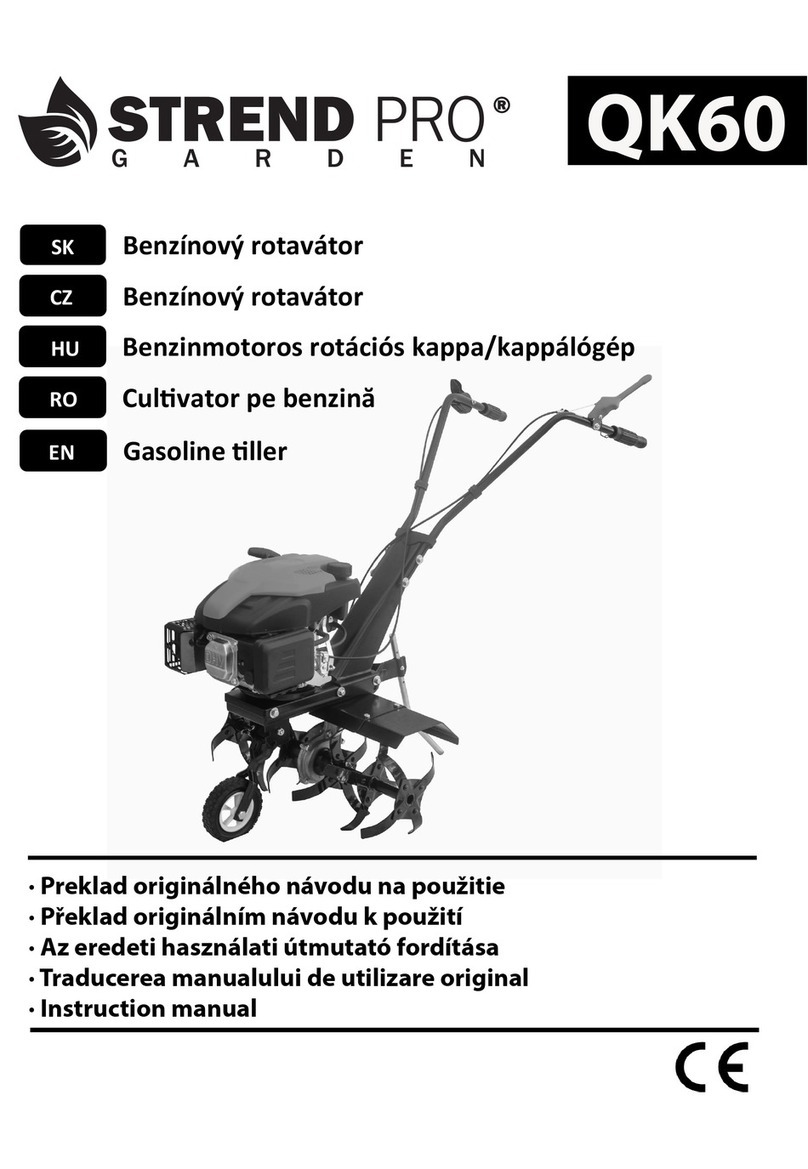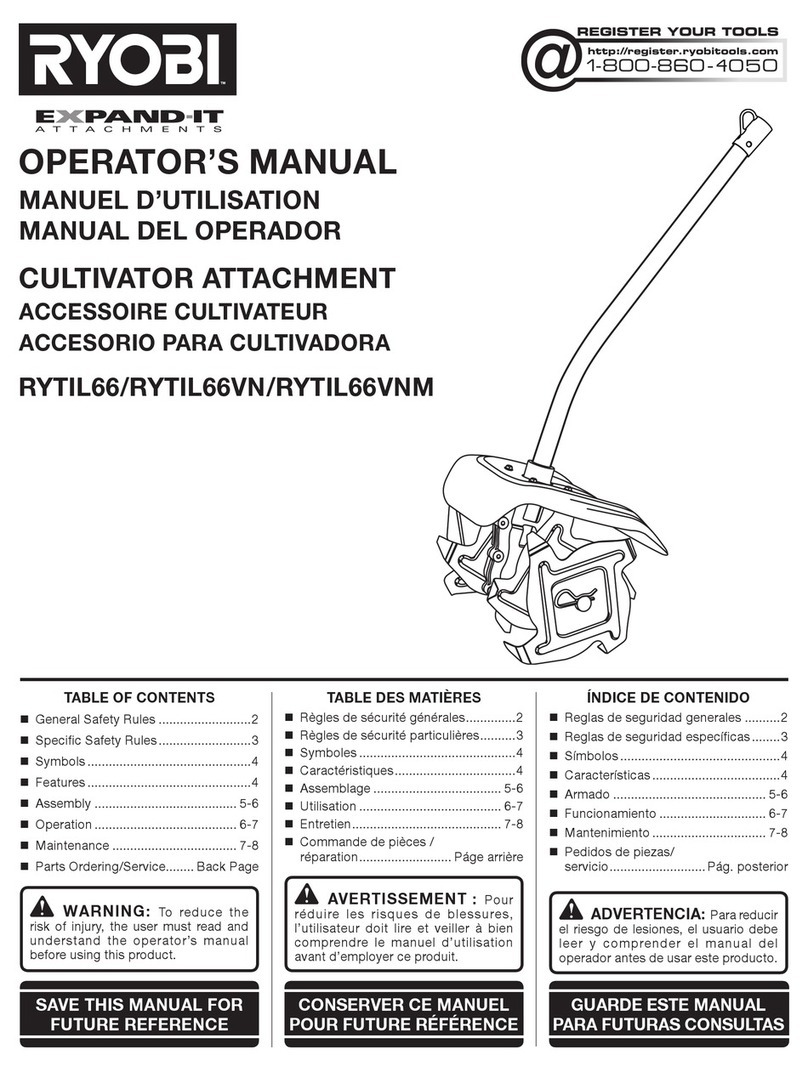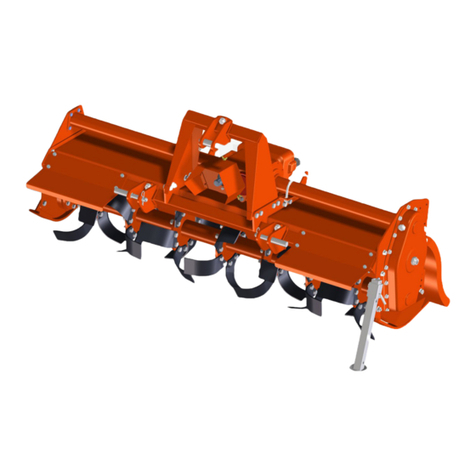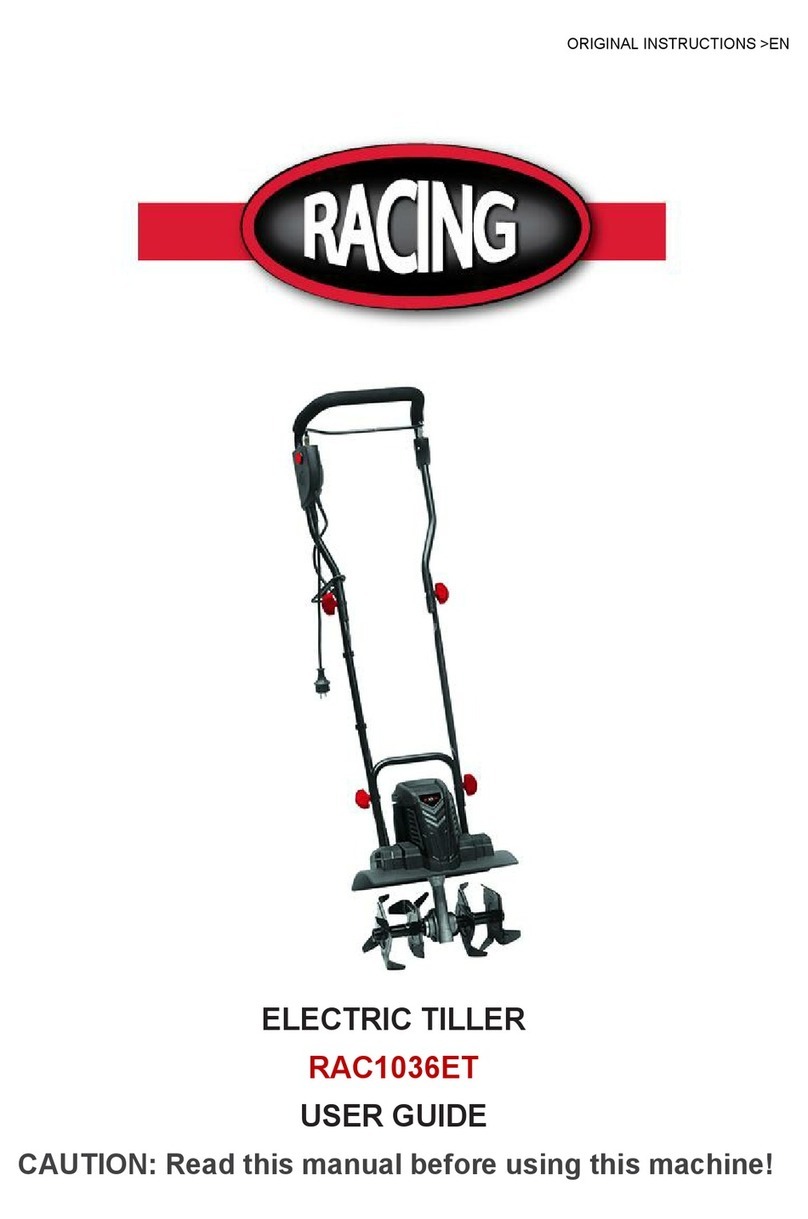Feider Machines FMTCPRO100 User manual

ORIGINAL INSTRUCTIONS
PETROL TILLER
INSTRUCTION MANUAL
FMTCPRO100
BUILDER SAS
ZI, 32 rue aristide Bergès – 31270 Cugnaux - France
MADE IN PRC 2020
CAUTION: Read the instructions carefully. Be familiar with the controls and the
proper use of the equipment

ORIGINAL INSTRUCTIONS
1. SAFETY WARNING:
For your safety and safety of others please pay special attention to these precautions:
1) Training
a) Read the instructions carefully. Be familiar with the controls and the proper use of the
equipment;
b) Never allow children or people unfamiliar with these instructions to use the machine. Local
regulations can restrict the age of the operator;
c) Never work while people, especially children, or pets are nearby;
d) Keep in mind that the operator or user is responsible for accidents or hazards occurring to
other people or their property.
2) Preparation
a) While working, always wear substantial footwear and long trousers. Do not operate the
equipment when barefoot or wearing open sandals;
b) Thoroughly inspect the area where the equipment is to be used and remove all objects which
can be thrown up by the machine;
c) WARNING – Petrol is highly flammable:
Store fuel in containers specifically designed for this purpose;
Refuel outdoors only and do not smoke while refuelling;
Add fuel before starting the engine. Never remove the cap of the fuel tank or add petrol
while the engine is running or when the engine is hot;
If petrol is spilled, do not attempt to start the engine but move the machine away from
the area of spillage and avoid creating any source of ignition until petrol vapours have
dissipated;
Replace all fuel tank and container caps securely;
d) Replace faulty silencers;
e) Before using, always visually inspect to see that the tools are not worn out or damaged.
Replace worn out or damaged elements and bolts in sets to preserve balance.
3) Operation
a) Do not operate the engine in a confined space where dangerous carbon monoxide fumes can
collect;
b) Work only in daylight or in good artificial light;
c) Always be sure of your footing on slopes;
d) Walk, never run with the machine;
e) For wheeled rotary machines, work across the slopes, never up and down;
f) Exercise extreme caution when changing direction on slopes;
g) Do not work on excessively steep slopes;
h) Use extreme caution when reversing or pulling the machine towards you;
i) Do not change the engine governor settings or overspeed the engine;
j) Start the engine carefully according to manufacturer instructions and with feet well away from
the tool(s);

ORIGINAL INSTRUCTIONS
k) Do not put your hands or feet near or under rotating parts;
l) Never pick up or carry a machine while the engine is running;
m) Stop the engine:
Whenever you leave the machine;
Before refueling;
n) Reduce the throttle setting during engine shut down and, if the engine is provided with a
shut-off valve, turn the fuel off at the conclusion of working;
4) Maintenance and storage
a) Keep all nuts, bolts and screws tight to ensure the equipment is in safe working condition;
b) Never store the equipment with petrol in the tank inside a building where fumes can reach an
open flame or spark;
c) Allow the engine to cool before storing in any enclosure;
d) To reduce the fire hazard, keep the engine, silencer, battery compartment and petrol storage
area free of vegetative material and excessive grease;
e) Replace worn or damaged parts for safety;
f) If the fuel tank has to be drained, this shall be done outdoors.
Thrown Object Hazard
Objects hit by the rotating tines can be thrown from the tiller with great force and may cause
severe injury.
1) Before tilling, clear the tilling area of sticks, large stones, wire, glass etc.
2) Pieces thrown from worn or damaged-tines can cause serious injury. Always inspect the
tines before using the tiller.
Fire and Burn Hazard
Gasoline is extremely flammable and gasoline vapor can explode.
Use extreme care when handing gasoline. Keep gasoline out of reach of children.
1) Refuel in a well-ventilated area with the engine stopped.
2) Allow the engine to cool before refueling. Fuel vapor or spilled fuel may be ignited.
3) The engine and exhaust system becomes very hot during operation and remains hot
after stopping. Touching them can cause burn injuries or some materials burn.
4) Avoid touching a hot engine or exhaust system.
5) Allow the engine to cool before performing maintenance or storing the tiller indoors.
Carbon Monoxide Poisoning Hazard
Exhaust contains poisonous carbon monoxide a colorless and odorless gas. Breathing exhaust
can cause loss of consciousness and may lead to death.

ORIGINAL INSTRUCTIONS
Operation on Slope
1) When tilling on slopes, keep the fuel tank with less than half oil to minimize fuel
spillage.
2) When the tiller walks across the slope, put your effort evenly while walking up and
down the slope.
3) Be very careful when changing the direction of the tiller on a slope.
4) Do not use the tiller on a slope of more than 10°.
5) The maximum safe grade angle shown is for reference only and the details should
depend on the type of the tool. Before starting the engine, check that the tiller is not damaged
and in good condition. For your safety or safety of others, pay special attention when using the
tiller up or down hill.
2. WARNING SYMBOL
Attention!
Caution: fire risk!
The part is extremely hot! Do not touch!
Read the instruction manual before use
Caution: Do not put your hands in belt when it
running.
Caution: rotating working tool!
Keep away from the machine.

ORIGINAL INSTRUCTIONS
Warning: Exhaust emissions are harmful to
health of body.
Add engine oil.
That the machine shall always be used in accordance with these manufacturer's instructions
the instruction handbook
The engine shall be stopped when carrying out maintenance and cleaning operations, when
changing tools and when being transported by means other than under its own power;
Some hazards can be met when working on slopes; work slowly by holding firmly the tool.
Do not transport the tool on slopes. The hazards can rise when working on difficult soil
(stony, hard, etc.). there is a risk to hit some objects, sliding, lose control for the machine
which will gives damages. Always inspect the working area before working, and always
watch what you are doing.
The adjustable part of the protective device shall be adjusted to the working depth of the tool
so that only that part of the working tool that cuts into the soil remains uncovered. This does
not apply to motor hoes.
The machine should only be operated by suitably trained persons.
During the operation of the machine safety shoes should be worn.
Always start up the machine under normal conditions
Intended use
This device is to be used only as an electric hoe for aerating lawns and grassy areas in private
home gardens and pleasure gardens. It is not intended for use in public spaces, parks, sports
fields, agriculture or forestry. Use of this device for any other purpose is considered incorrect
and unapproved. The manufacturer will not be responsible for any damage or injury resulting
from such use. The user is fully responsible for all related risks.

ORIGINAL INSTRUCTIONS
3. Tiller description
1).The main technical parameters
Power: 4 kW
Speed: 3600/min
Oil volume ( l ) :0.6.
Fuel tank capacity (l): 3.6
Power tiller
Packing SIZE (L x W x H(mm): 900x460x660
Weight: 114kg/75/kg
Working width (mm): 1000
Working depth (mm) :100-160
Guarantee sound power level: 98 dB(A)
Sound power level measured : Left: 78,9 dB(A)Right: 80dB(A)
Sound pressure level measured: 94.1 dB(A).
Vibration value:Left: 6,14m/s² Right: 5,48 m/s²K=1,5m/s²
Engine
Engine model H170F
Type:single cylinder, OHV four-stroke,forced air coolingDisplacement
212 cm3

ORIGINAL INSTRUCTIONS
2).Know your machine
1. Handle
2. Petrol engine
3. Side disc
4. Handlebar adjustment
5. Fender
6. Blades
7. Depth regulator
8. Gear change lever
9. Clutch lever
10. ON/OFF Switch
11. Throttle switch
12.Bumper
13.Front Support wheel
1
2
3
3
5
6
7
8
9
10
11
3
12
13
4

ORIGINAL INSTRUCTIONS
3).Daily inspection
WARNING:
Always use 4-stroke quality oil engine. If you use a different type of oil, the service
life of the engine will be shortened. Keep the engine in a horizontal position. If oil is
spilled as a result of rotation, wipe clean.
4. Tiller installation and use
1). Tiller assembly
Before leaving the factory, the main parts of the power tiller have been checked. However, those
using the machine in micro cultures must contact a shop for checking and adjustment so that the
power tiller offers an improved performance. Owners must follow the following step to assemble
it:
1) The wheel must be installed in the gearbox, at the hex shaft at both sides of the
transmission shaft with locking screws.
2) Place the arm in the body in the position required on the basis of the terrain in relation to the
axis and insert the depth regulator at the basis of the tiller.
3) Armrest handle. Pull from the armrest handle at the upper section of the semicircle with the
armrest covered and the screw in relief as shown on Figure A below.
4) Pull up the armrest by pull from the plastic handle. The armrest may be 360 degrees.
5) Mount the fender on the engine fixed support and the body.
.
WARNING:
This is a 0.6 l engine. if the level of oil is below normal and you continue to use the
machine, the engine will be seriously damaged.

ORIGINAL INSTRUCTIONS
Empty the oil, check that the oil level is normal. Oil SAE15W-40 is recommended for
general lubrication and is suitable for a general environment temperature
2). CHECK OIL IN THE GEARBOX.
Place the machine on la flat surface for working. Unscrew the oil level. The normal value is
1.5 l. If too low, add oil up to normal value.
SAE15W is the recommended oil -40.

ORIGINAL INSTRUCTIONS
3) . Check air filters
If the engine were operating without a filter, engine wear would accelerate.
4) Tiller adjustment method,
(1) Assembling the handle and height adjustment
WARNING:
In order to adjust handle height Begin by placing the parts on a flat terrain to prevent the
machine from skidding. (Figure 5) Loosen the adjusting bolt, place the handle at waist level and
then fasten the belt adjustment. (Figure 6)
(2) Tilling depth adjustment. The height of the bar can be adjusted as well as the rotation control,
the tilling and cutting depth. (Figure 7)

ORIGINAL INSTRUCTIONS
5) THE CLUTCH AND ITS ADJUSTMENT
WARNING:
Before using the clutch, slow down the engine. Use the clutch to control engine output. By
loosening the clutch level the power input will result in the engine stopping and the tilling
blade will also stop. By pressing the clutch, the power input will result in the engine starting
to till with the rotating blade (figure 8)
Note: If clutch levers are poorly adjusted, this will have consequences for the normal
operation of the machine. Begin by confirming that the clutch levers have normal degrees of
tension. Normal lever degrees should be between 4 and 8 mm free. Then,the adjustment of
the counter nut must be loosened. Adjust properly after stopping. (FIG 9)
Start the engine when necessary and check the clutch.

ORIGINAL INSTRUCTIONS
6) ADJUSTING THE THROTTLE LEVERS.
Reach of normal idle speed: 1600 +-150 RPM; high speed: 3600 r/min. You can use the
speed adjustment table.
Speed confirmation and adjustment method
(1) Do not apply any load, place the throttle knob on the maximum adjustment position and
check whether the data on the speed table show 3600. Do not apply any load, place the
throttle knob on the maximum adjustment position and check whether the data shown
on the speed table shows are 1600 +- 150.
(2) If the data shown do not correspond to those for petrol engine, some adjustment will be
required.
The following are some specific measures that may be required:
Check every pressure regulator seal to make sure they have not come off and are
properly attached.
Do not apply any load, place the pressure regulator knobs in the maximum adjustment
position, then adjust the petrol engine in the throttle combination. Place the speed
adjustment screws on the correct position.
If you are going to operate the machine for a long period of time, you can adjust the
pressure regulator at the fine adjustment screw.
5. Operating instructions
A. Check and oil
(1) Check the connection screws for tightness and consult the table below to tighten them
in accordance with the torque requirements for these screws. Consult the instructions
manual for the closed screws in the petrol engine, nuts and petrol engine torque.

ORIGINAL INSTRUCTIONS
Name Torque (N.m)
Connection and petrol engine 20~25
Connection and transmission 35~40
The gearbox after the screw 10~12
Reverse transmission shaft fastening screws 26~40
Support structure and engine box 35~40
Screw covering mobile device 35~40
Screw covering mobile mechanism 50~60
The mobile mechanism and the connecting screws of the gearbox 35~40
Body 45~60
Petrol engine fixed screw 35~40
Screw preserving the armrest support structure. 35~40
(2) Make sure that the operating system of the knob, throttle, the clutch the gear lever, the
reverse lever and the sudden stop is flexible and is in the right place.
(3) Put the gear lever in neutral.
(4) Add oil:
1Crankcase engine lubricating oil SAE15W-40 and specific methods.
2Speed with lubricating oil SAE15W-40. The level is stabilised by adding oil through
the oil feeder on the gearbox. Check that the level of oil is within the specified
range. If not, add as necessary.
3Air filter. Remove air filter cap and add approximately 0.1 litres of SAE15W-40 oil.
4On the basis of environment temperature, select the suitable engine oil from the
table.
5Resupply: add -10 # petrol oil into the fuel tank (see instructions for using a petrol
engine). Note: Do not exceed the upper limit.
6Follow the instructions before preparing the engine to begin to work.

ORIGINAL INSTRUCTIONS
B. Start
Note: The gear lever must be neutral and your hand ready in the event of an emergency
stop.
1) Petrol engine operation instructions must be observed, including the steps before
starting the engine.
2) The petrol engine must be idle (1600 +-150 r/min) without load 2 ~ 3 minutes.
3) Make sure that the engine operates properly. Otherwise, stop the machine.
C. Operation
Note: before using the machine, the operator needs to familiarise with the operating
speed of the tiller.
1) Low speed when operating on slopes.
a. Loosen the clutch with the left hand.
b. Use the right hand to pull from the gear lever to change down. Then, hold the right
side of the handle again.
c. Slowly with your left hand press the clutch and you can work now with the power
tiller at a lower speed.
d. A power tiller at low speed should be operating at about 4.5 km/h
2) High speed on slopes.
a. Loosen the clutch with the left hand.
b. Use the right hand to pull from the gear lever to change gear. Then, hold the right
side of the handle again.
c. Slowly with your left hand press the clutch and you can work now with the power
tiller at a higher speed.
d. A power tiller at high speed should be operating at about 8 km/h
3) Reverse on slopes
a. Loosen the clutch with the left hand.
b. Use the right hand to pull the gear lever down and pay attention if in position.
c. Slowly with your left hand press the clutch and then the micro power tiller will
reverse.
4) Use the handlebar to turn left or right.
5) Short-distance transportation.
a. Loosen the clutch.
b. With the gear lever in neutral, turn throttle regulator clockwise toward the minimum
position. The machine will stop and press the ON/OFF Switch with your hand.
c. If the engine should need petrol,follow the instructions for a petrol engine when
refuelling.(note: the micro power tiller should be placed on a flat surface)

ORIGINAL INSTRUCTIONS
6) SUPPORTING THE CONNECTION DIRECTION TO BE USED.
a. If you need to turn while you till, remove the wheel and the device of the hex tube
will rotate with 8*50 of the axis of the fixed peg and screw to be removed. Once the
tiller rotating blade is installed, you must install a safety protection guard for
operating the machine. You can adjust the cutting speed, the height from the
ground and the angle to achieve a different harvesting depth.
b. If you need to open a trench, lower the speed, make the trench and adjust the
depth and width required for the trench. (Figure 3)
Stretching the width of the ditch: 14 cm x 40 cm. Stretching the width of the ditch: 11 cm x 25
cm.
c. Short-distance transportation. Rated load: 250 kg the calibration of the speed of the
petrol engine must be: high speed at 8 km/h and low speed at around 4.5 km/h.
7) THINGS TO BEAR IN MIND REGARDING THE MICRO POWER TILLER.
a. Pay careful attention to the working conditions and environment before using the
machine. All parts and connections must be inspected to check they are in good
working conditions. If you should discover something out of the ordinary, stop the
machine and inspect.
b. Do not start to work with a cold machine, particularly in the case of new machines
or start working with heavy loads.
c. Check that the level of oil in the petrol engine and the transmission. if insufficient,
add oil.
d. The use of water to cool down the engine is prohibited.
e. After using the machine, remote the mud, the weed and the lubricating oil from the
plough. Keep it clean to prevent it from rusting.
f. Frequently wipe the machine body using a sponge and change oil.
g. Choosing gears You can choose among five gears when operating the power tiller.
How to change gears:
a) Turn the throttle switch in the opposite director (left - minimum)
b) Press the clutch.
c) Move the gear mechanism as required for your needs.
d) Loosen the clutch and the power tiller will be ready for operation. Loosen the
clutch.

ORIGINAL INSTRUCTIONS
e) When the side distance of the gear is under 0.05 mm you must increase the
adjustment mat 1 (0.2 to 0.3 mm) to increase lateral distance and replace the
seal paper 2 to ensure that the axial difference of gear 2 is between 0.05 and
0.15 mm.
f) When the lateral distance of the gear is higher than 0.3 mm reduce the
adjustment mat 1 and at the same time make sure that the axial distance
between gear 2 is between 0.05 and 0.15 mm; or increase the adjustment of
seal 2, making sure that the axle distance between the gears is between 0.05
and 0.15 mm
8) Method for adjusting the reverse lever and the cable line.
When confirming that the tiller does not return to its normal driving condition, see chapter 4
for correction.
Note:
(1) Press and release the reverse lever 2 ~ 3 times and confirm gear. If it does not
operate normally, contact someone qualified to examine it.
(2) When using the power tiller, you must loosen the reverse lever and the reverse

ORIGINAL INSTRUCTIONS
must return without hitting the transmission gear. Pay attention to any abnormal noise
as the gear may be damaged.
(3) Clutch cable adjustment method The use of the machine will lead to some wear
and tear from friction resulting in the clutch holder which regulates the clutch cable. See
chapter 3 for further information.
(4) When confirming that the tiller does not return to its normal driving condition, see
chapter 4 for correction.
Note:
(1) Press and release the reverse lever 2 ~ 3 tines and check the gear. Adjust if it not
as required.
(2) If repeated adjustments do not solve the problem and you see that the clutch cable
is worn, replace it for a new one.
(3) Removing the clutch is strictly prohibited as the clutch and other parts may be
damaged.
(4) Clutch cable adjustment method.
When turning the throttle switch, the engine may increase or decrease its speed.
Note:
(1) Repeatedly turning the throttle switch 2 ~ 3 in a petrol plus engine, must loosen and
confirm performance.
(2) Use screws for connecting the throttle cable and the adjoining levers.
9) USING THE HANDLEBAR STRUCTURE AND ADJUSTMENT METHOD
You can adjust the handlebar right, left, up and down according to your height requirements
and the specific farming and ploughing
requirements. The method is as follows:
1. At the handlebar, adjust:
·· The regulating handle.
·· Select the best position of the handle structure for the operating height required.
·· Then, loosen the regulating handle, insert the bars into the corresponding hole until the
handlebar is properly adjusted.
2. Adjusting the right, left armrest handle.
·· Manually hold the level of the regulator handle mentioned on the bars.
·· Turn the handlebar structure to the left and to the right again if needed.
·· Once released, insert the corresponding handle in the hole and decide if you wish to
move the handlebar structure to the left or to the right.
Note: To ensure that the rotating tines maintain a proper safety distance, please
check that the left-right rotating angle of the handlebar structure is not below 35
degrees.

ORIGINAL INSTRUCTIONS
·· You can control the handle bar upwards and downwards using the height handle and the
T locking.
6. Tiller Maintenance
As this machine is used in agriculture, the friction, wear and tear and the changes in
workload, parts of the machine may get loose or get worn, the petrol engine may switch off,
the consumption of fuel may increase, all of which will have serious repercussions for the
performance of the machine. To reduce the problems listed above, strictly follow the
scheduled maintenance for longer service life and good technical performance.
A. INTEGRATION.
1. Please, consult the petrol engine instructions manual.
2. A new power tiller must be initially operated with no load under light load conditions and
five hours immediately starting the engine and when all the lubricating oil is hot in the petrol
engine and the crankcase.
B. TECHNICAL MAINTENANCE OF THE POWER TILLER
Types of maintenance (before and later)
1. Listen and observe whether there are abnormal phenomena (strange noises, overheating,
loose screws, etc...)
2. Check the petrol engine and the gearbox for oil spillage.
3. Make sure that oil levels in the engine and gearbox are within the recommended ranges.
4. Keep the machine clean and free form weeds, grease and dirt.
5. Fill in the maintenance table.
1. Level 1 maintenance (after 150 hours of work).
·· Clean the gearbox and replace oil.
·· Check and service the clutch, the gearbox and the reverse.
2. Level 2 maintenance (after 800 hours of work)
·· Clean the gearbox and replace oil.
·· Check and service the clutch, the gearbox and the reverse.
·· Check all the gears for wear and replace when necessary.
·· If the tines or the connection screws are damaged, replace them for new ones.
3. Technical repair (after between 1500 and 2000 hours of work).
·· 1) You must disassemble, clean and check for worn parts. Replace or repair as required.
·· Please, contact a professional for clutch maintenance.
4. Maintenance of the machine and petrol engine. Please check the petrol engine
instructions manual.
C. TECHNICAL MAINTENANCE OF THE TILLER ( THE SIGN * IS SHOWN IN THE
CONTENT TABLE TO INDICATE THAT MAINTENANCE IS REQUIRED).
D. LONG TERM MAINTENANCE OF THE POWER TILLER.
Farm machinery is often stored for long periods of time. To prevent corrosion, the following
steps must be taken:
1. Follow the guidelines for long term storage of a petrol engine.

ORIGINAL INSTRUCTIONS
2. Clean any visible dirt and dust.
3. Check oil in the gearbox.
4. Do apply paint on the aluminum alloy surface.
5. Parts must be kept indoor and in a well-ventilated place.
6. Keep the equipment, the product certificate and the instructions manual.
7. CE Declaration of conformity
CE Declaration of conformity
BUILDER
ZI, 32, rue Aristide Bergès – 31270 Cugnaux - France
Declares that the machinery designated below:
PETROL TILLER
INSTRUCTION MANUAL
FMTCPRO100
Serial number: 20200726010-20200726019/20200903118-20200903127
Complies with the provisions of the Directive "machinery" 2006/42 / EC and the national
regulations transposing it;
Also complies with the following European directives:
Emission Directive (EU) 2016/1628 and 2018/989/EU
Directive EMC 2014/30 /EU
Also complies with European standards, national standards and technical provisions following
EN 709:1997+A4; EN ISO 14982:2009
Cugnaux, le 20/06/2020
Philippe MARIE / PDG

WARRANTY
The manufacturer guarantees the product against defects in material and workmanship for a period of 2
years from the date of the original purchase. The warranty only applies if the product is for household use.
The warranty does not cover breakdowns due to normal wear and tear.
The manufacturer agrees to replace parts identied as defective by the designated distributor. The
manufacturer does not accept responsibility for the replacement of the machine, in whole or in part , and/or
ensuing damage.
The warranty does not cover breakdowns due to:
• insucient maintenance.
• abnormal assembly, adjustment or operations of the product.
• parts subject to normal wear and tear.
The warranty does not extend to:
• shipping and packaging costs.
• using the tool for a purpose other than that for which it was designed.
• the use and maintenance of the machine done in a manner not described in the user manual.
Due to our policy of continuous product improvement, we reserve the right to alter or change specications
without notice. Consequently, the product may be dierent from the information contained therein, but a
modication will be undertaken without notice if it is recognized as an improvement of the preceding
characteristic.
READ THE MANUAL CAREFULLY BEFORE USING THE MACHINE.
When ordering spare parts, please indicate the part number or code, you can nd this in the spare parts list
in this manual. Keep the purchase receipt; without it, the warranty is invalid. To help you with your product,
we invite you to contact us by phone or via our website:
• +33 (0)9.70.75.30.30
• https://services.swap-europe.com/contact
You must create a "ticket" via the web platform.
• Register or create your account.
• Indicate the reference of the tool.
• Choose the subject of your request.
• Describe your problem.
• Attach these les: invoice or sales receipt, photo
of the identication plate (serial number), photo
of the part you need (for example: pins on the
transformer plug which are broken).
8. WARRANTY
Table of contents
Other Feider Machines Tiller manuals
